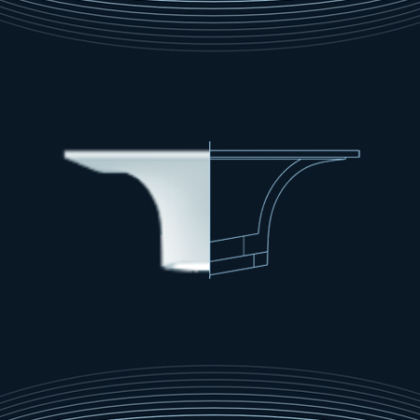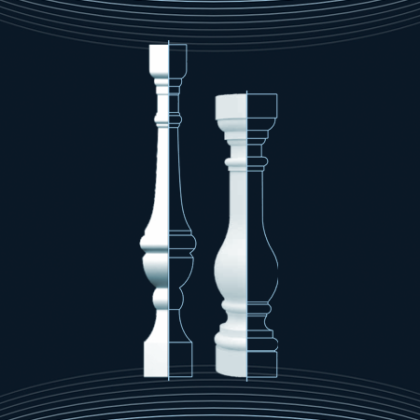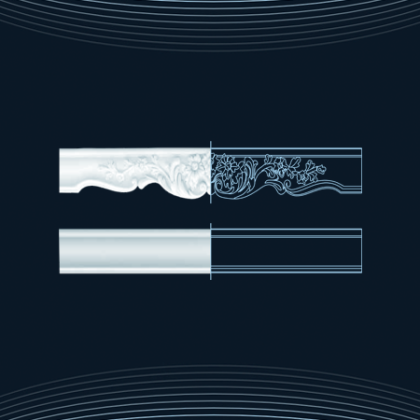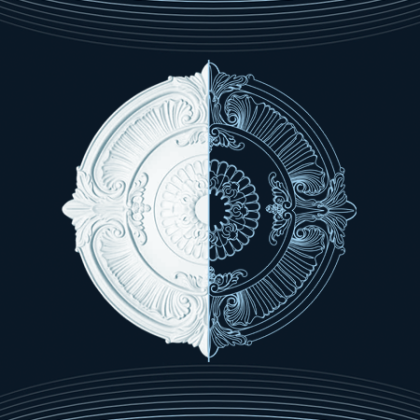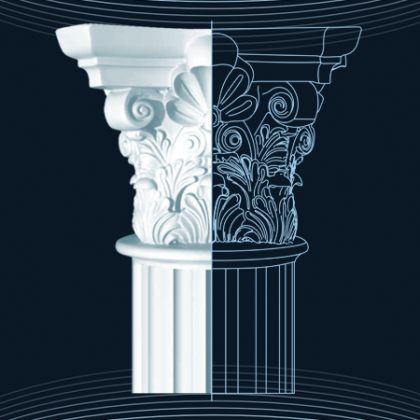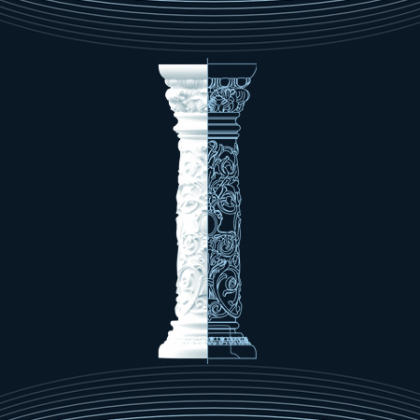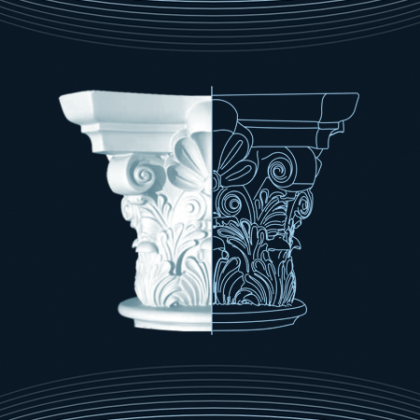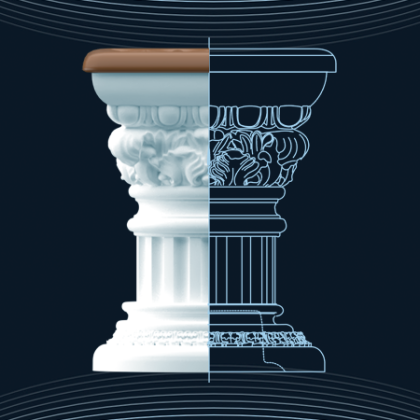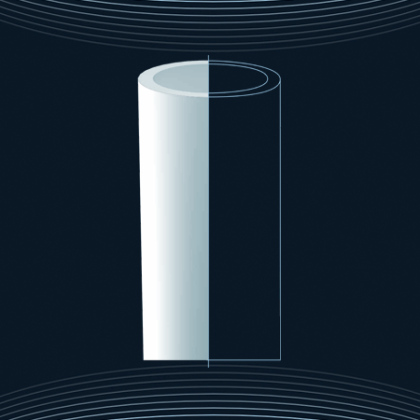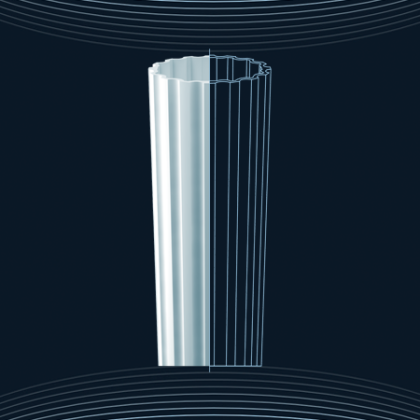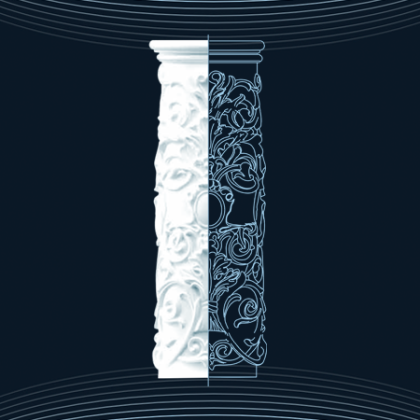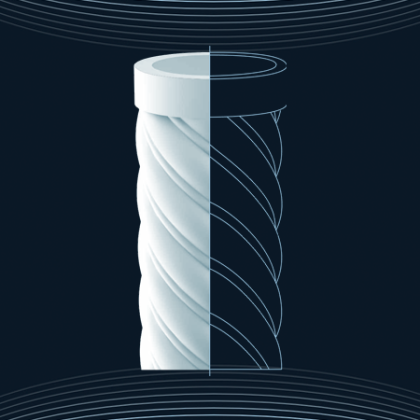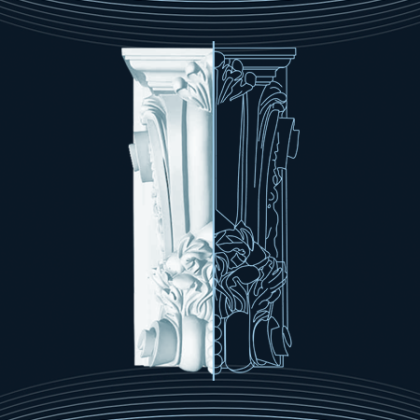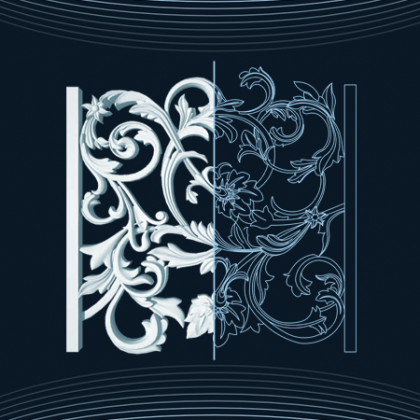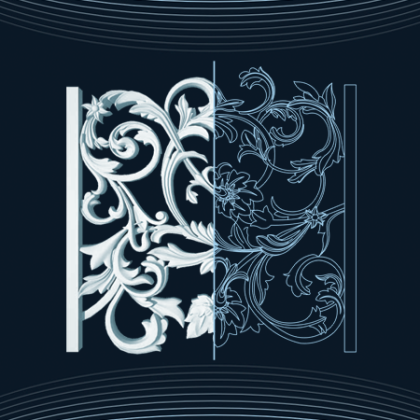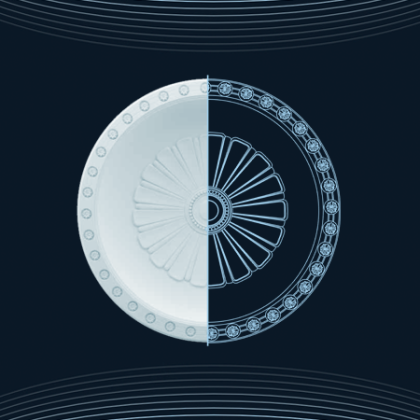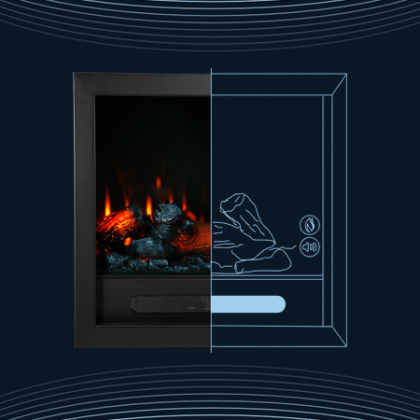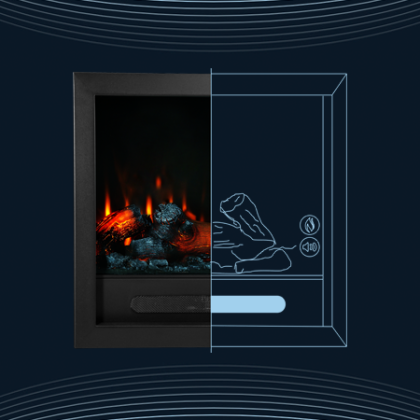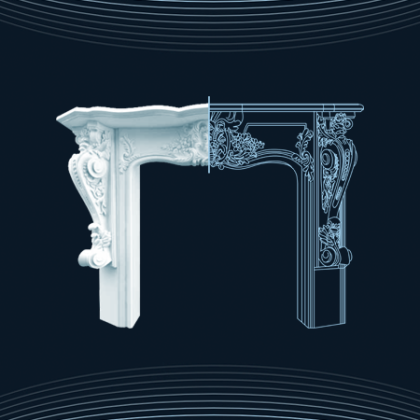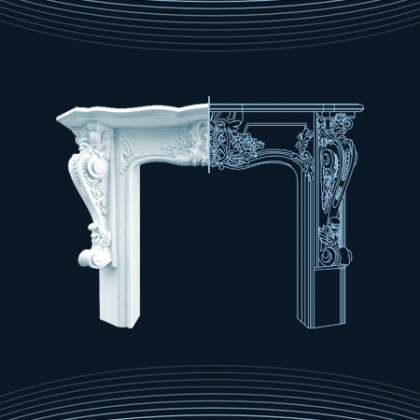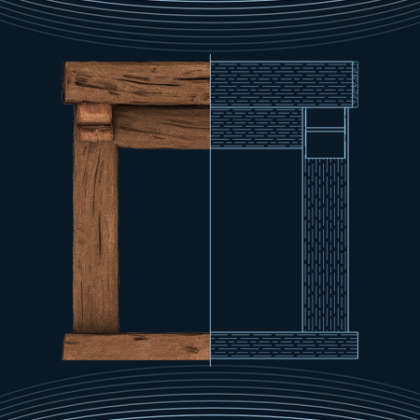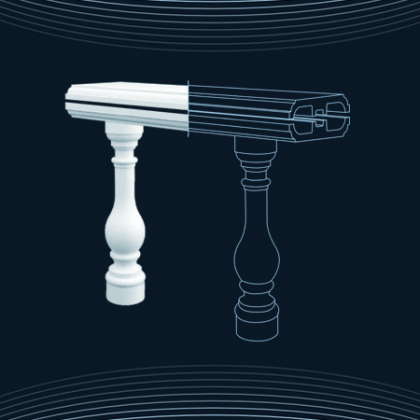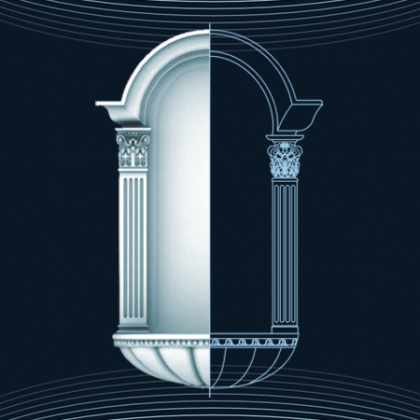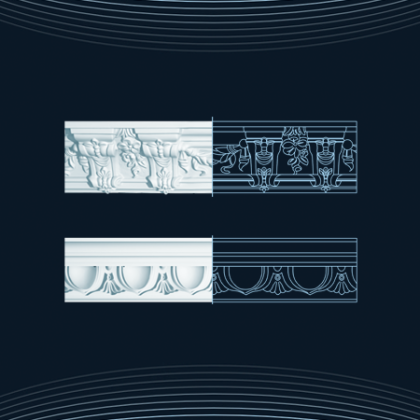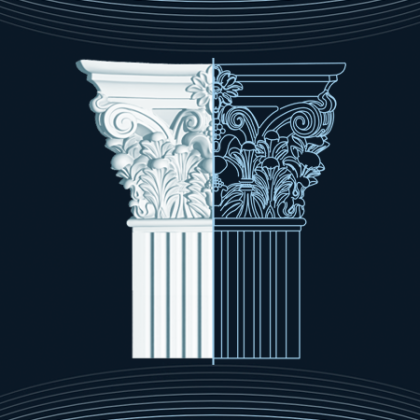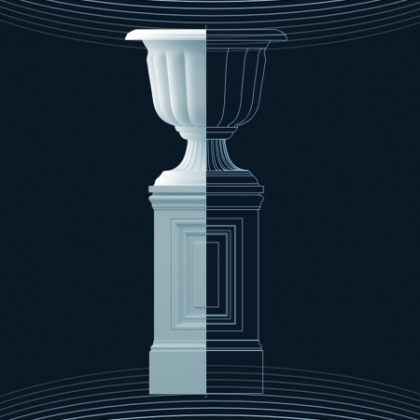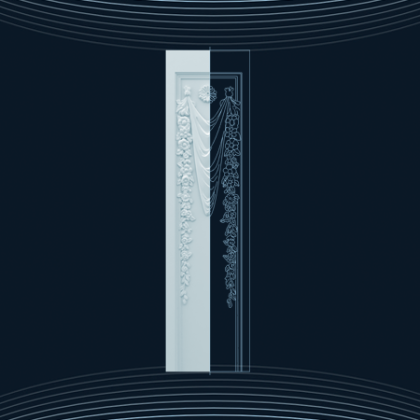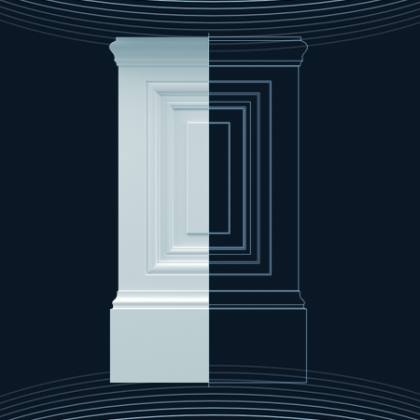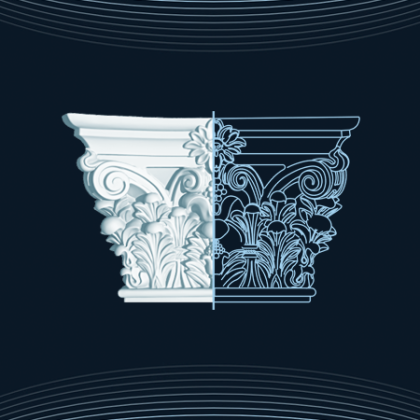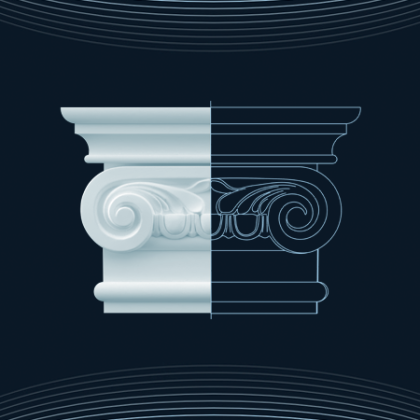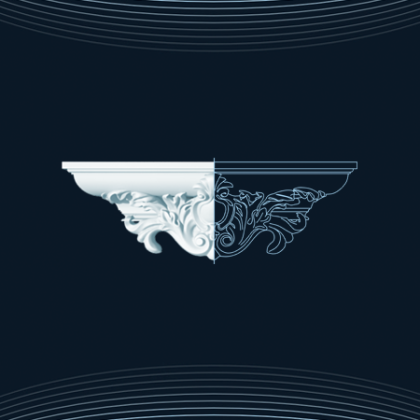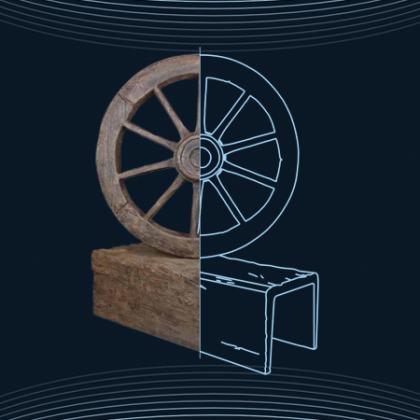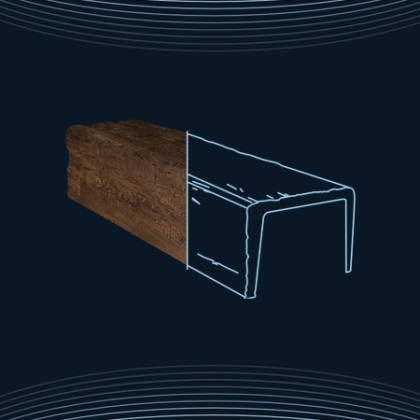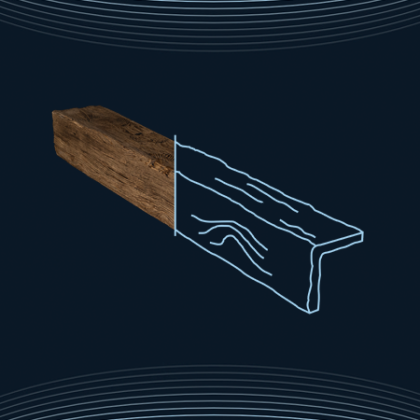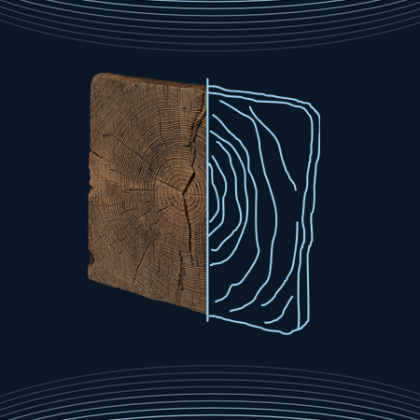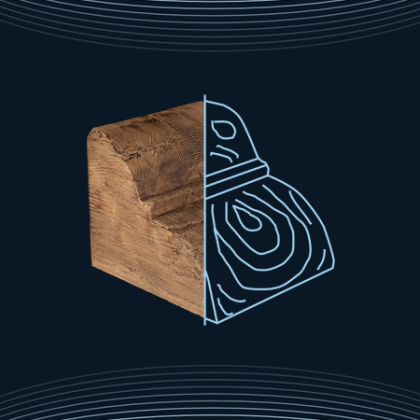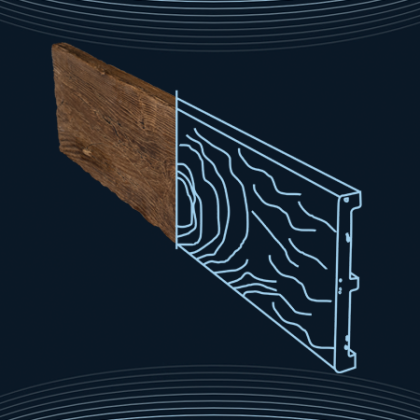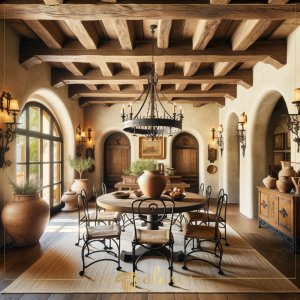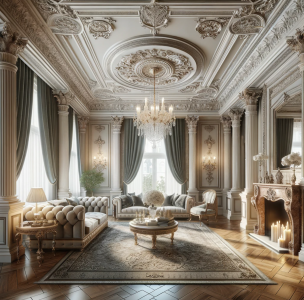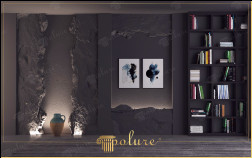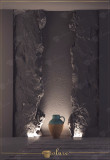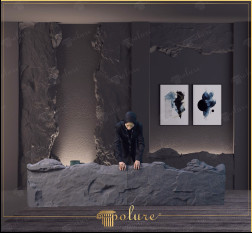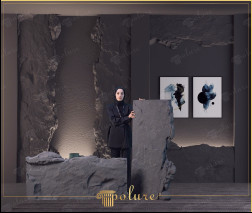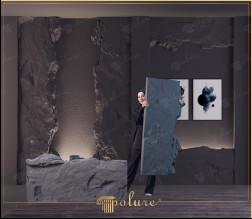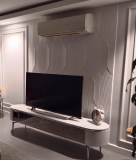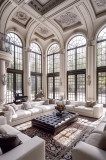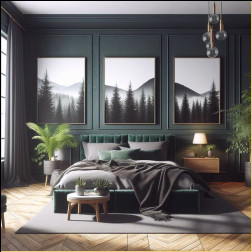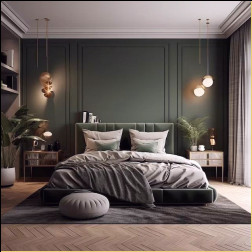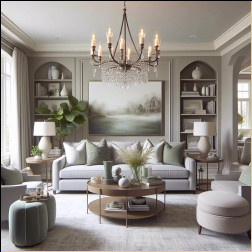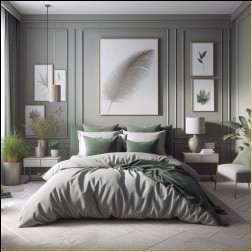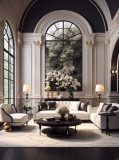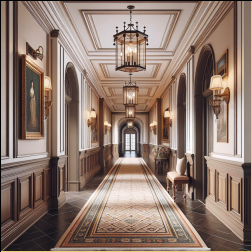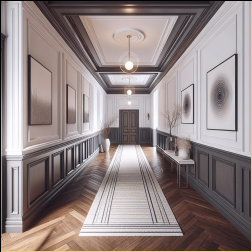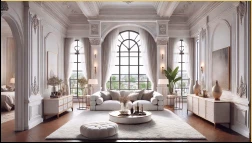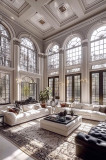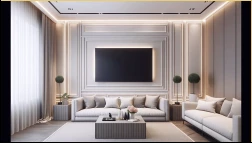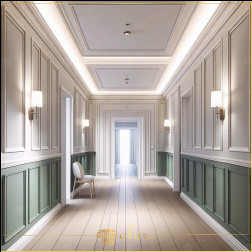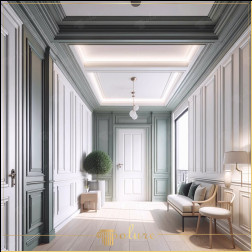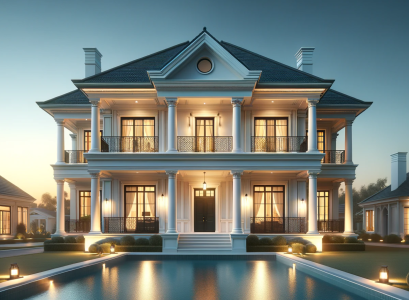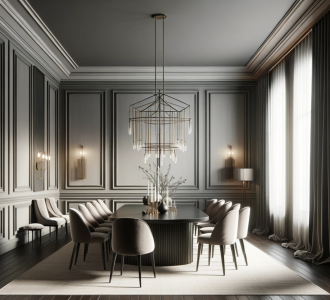684 - Rock Look Polyurethane Panel LED hidden light lighting living room wall decoration
Living Room Wall Decoration with Rock-Looking Polyurethane Panel and LED Hidden Light Lighting Solutions that offer aesthetics and functionality toget
The used products!683 - Create an article about Rock Panel LED hidden light lighting Rock Look Polyurethane Panel
Rock Panel LED Hidden Light Lighting Modern Decoration Solutions with Rock Look Polyurethane Panel Decoration trends bring innovative solutions that w
The used products!682 - Rock Panel LED hidden light lighting Rock Look Polyurethane Panel
Rock Panel Led Hidden Light Lighting Aesthetics in Decoration with Rock Look Polyurethane Panels Lighting, which is one of the indispensable elements
The used products!681 - Rock Panel Living Room Decor Rock Look Polyurethane Panel
Rock Panel Living Room Decor Catch the Elegance with Rock Look Polyurethane Panels For those who want to create a natural and impressive atmosphere in
The used products!680 - Canyon Rock Look Decorative Polyurethane Wall Panels
Canyon Rock Look Decorative Polyurethane Wall Panels Natural and Aesthetic Solution Today, aesthetic durability and easy applicability are sought toge
The used products!679 - Rock look Polyurethane wall panel
Polyurethane Rock Look Wall Panels Aesthetic and Functional Decoration Solutions Today, polyurethane rock look wall panels, which offer the impressive
The used products!678 - Decorating the living room behind the TV with Polyurethane Wall Panel
Decorating Ideas Behind the TV with Polyurethane Wall Panels in Living Rooms Living rooms are one of the parts of our homes where we spend most of our
The used products!677 - High ceiling Living Room Decoration neo classic
Neo Classic High Ceiling Living Room Decoration Capture the Magnificence with Polyurethane Details The decoration of a living room with a high ceiling
The used products!666 - Bedroom Design Ideas
BEDROOM INTERIOR DESIGN Personalized Bedroom Designs to Suit Your Style Quality and Sustainability Innovative Solutions Bedroom Design
The used products!665 - Bedroom Decoration
Small Bedroom Design Bedroom Accessory Ideas Bedroom Decoration Ideas
The used products!664 - Living room decoration
Modern living room decoration Simple stylish living room decoration New trend living room decoration Simple stylish living room decoration pinterest
The used products!663 - Bedroom Decoration
Modern Bedroom decoration Simple stylish Bedroom decoration New trend Bedroom decoration Simple stylish living room decoration pinterest Spacious Bed
The used products!662 - Hall Decoration Plaster columns and arches
Hall Decoration Plaster columns and arches
The used products!659 - Living room decoration models with columns
Here is a luxury living room design This design features large arched windows elegant moldings and high ceilings The room feels large and spacious nat
The used products!658 - Living room decor column and arch models
Living room decor column and arch models
The used products!656 - Modern Decoration with Sophistication Polyurethane Slats and Skirtings that Transform Your Hallway
Corridor decoration greatly affects the general aesthetics of a house, and the choices made in these areas are elements that clarify the character of
The used products!655 - The Modern Touch of Aesthetic Polyurethane Redefined in Corridor Decoration
Corridor decoration is an important part of the house both functionally and aesthetically. Corridors modernized with polyurethane lath, border, plaste
The used products!Interior Decoration - Interior Decoration design models examples and ideas - Polyurethane Decor
Transform Your Space with Durable Polyurethane Decor Unlock the potential of polyurethane interior decoration to bring both elegance and durability into your home or commercial space. Known for its robustness and easy maintenance, polyurethane stands out as a superior choice for creating sophisticated environments without the high costs associated with natural materials. Why Choose Polyurethane for Your Interiors? Polyurethane offers unparalleled durability, resisting wear, tear, and environmental damage, making it perfect for busy spaces. Its ease of maintenance ensures that spills and stains can be wiped away effortlessly. Moreover, the versatility of polyurethane allows for the crafting of intricate designs, from crown molding to decorative panels, adding depth and character to any room. Top Picks for Polyurethane Decor Crown Molding: Instantly elevate the look of your ceilings and walls. Wall Panels: Add texture and dimension to your rooms. Baseboards: Create a smooth transition from wall to floor. Door and Window Casings: Frame your doors and windows beautifully. Column and Pilaster Kits: Incorporate architectural detail effortlessly. Thanks to advancements in manufacturing, polyurethane decorations now offer a realism that rivals natural materials, at a fraction of the cost. This makes polyurethane a go-to choice for both renovation projects and new constructions seeking style, sustainability, and longevity. Conclusion Embrace the blend of aesthetic appeal, durability, and versatility offered by polyurethane interior decoration models. Whether upgrading your home or designing a commercial space, polyurethane provides an array of options to meet diverse needs and preferences, securing its place as a favored material in the future of interior design.
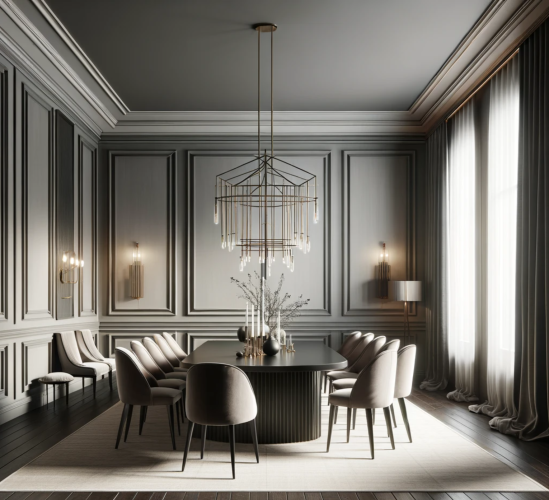
Polyurethane interior decoration refers to using polyurethane-based materials for decorating the inside of buildings. These materials can include things like moldings, trim, and other decorative elements that enhance the look of a room or space.
Polyurethane interior decoration refers to the use of polyurethane materials in the design and embellishment of indoor spaces. Polyurethane, a versatile and durable polymer, is increasingly popular in the world of interior design due to its flexibility, resilience, and aesthetic appeal. This material can be found in a wide range of interior decoration elements, from furniture and moldings to wall panels and flooring. One of the main advantages of using polyurethane in interior decoration is its durability. Polyurethane finishes are known for their ability to resist wear, tear, and environmental factors, making them ideal for high-traffic areas. Additionally, polyurethane is water-resistant, which further extends its lifespan and makes it suitable for use in kitchens and bathrooms. Another significant benefit is the aesthetic versatility of polyurethane. It can be molded into various shapes and designs, allowing for custom and intricate decorative elements. Furthermore, polyurethane can mimic the look of more expensive materials like wood and stone, providing an economical alternative without compromising on style. Polyurethane is used in a myriad of ways in interior decoration. Some of the most common applications include: In conclusion, polyurethane interior decoration offers a blend of durability, versatility, and aesthetic appeal that is hard to match with other materials. Whether used in furniture, wall panels, or decorative accents, polyurethane can elevate the look and feel of any space. As technology and material science continue to advance, the possibilities for innovative and sustainable interior design with polyurethane are bound to expand even further.Polyurethane Interior Decoration
Advantages of Polyurethane in Interior Decoration
Applications of Polyurethane in Interior Decoration
Conclusion
Interior decoration has a significant role in history, reflecting cultural, social, and economic changes through time. It shows how people's tastes, technologies, and materials have evolved, influencing how we design and adorn our living spaces today.
Interior decoration, an art and science devoted to making the interior space more aesthetically pleasing and functionally useful, has a rich history that spans thousands of years. From the ornate designs of ancient Egyptian palaces to the minimalist trends of modern-day homes, interior decoration has continuously evolved, reflecting the cultural, social, and technological changes of its time. The roots of interior decoration can be traced back to ancient civilizations like Egypt, where the interiors of pyramids and tombs were intricately designed with paintings, carvings, and furniture that signified the status and beliefs of their inhabitants. Similarly, ancient Romans and Greeks used interior decoration to display wealth and sophistication through elaborate mosaics, wall paintings, and luxurious textiles. During the Middle Ages, the focus of interior decoration shifted towards functionality, with less emphasis on aesthetics. However, the Renaissance period saw a revival of interest in beauty and the arts, including interior decoration. Wealthy patrons employed skilled artisans to create opulent spaces filled with detailed frescoes, ornate furniture, and rich tapestries. The Industrial Revolution brought about significant changes in interior decoration. Mass production made decorative items more accessible, leading to an increase in interior design's popularity among the middle class. The 20th century saw the emergence of professional interior decorators and the establishment of interior design as a recognized profession. Influential movements such as Art Deco, Minimalism, and Mid-Century Modern further shaped the evolution of interior decoration, emphasizing different aspects of design such as functionality, simplicity, and the use of modern materials. Today, interior decoration is a dynamic field that incorporates a wide range of styles, techniques, and materials. Advances in technology have introduced new possibilities in design, from sustainable materials to smart home systems, allowing for innovative approaches to creating comfortable, aesthetically pleasing spaces. Interior decoration continues to reflect the times, embracing diversity, sustainability, and personal expression. The place of interior decoration in history is not just a testament to humanity's desire for beauty and comfort but also a mirror reflecting the technological, social, and cultural shifts across eras. As we move forward, the field of interior decoration is set to evolve further, continuing to shape and be shaped by the way we live.The Place of Interior Decoration in History
Ancient Beginnings
The Middle Ages to the Renaissance
The Industrial Revolution to Modern Times
Contemporary Interior Decoration
Conclusion
Polyurethane is widely used in interior decoration due to its durability, flexibility, and resistance to wear and tear. It can mimic the look of wood or painted surfaces, is easy to clean, and provides a protective layer that resists stains and scratches. Polyurethane finishes are available in various sheens, from matte to glossy, allowing for customization according to design preferences. This material is also moisture-resistant, making it suitable for areas with high humidity levels. Its lightweight nature facilitates easy installation and handling. Polyurethane decorative elements can include moldings, trims, and panels, enhancing the aesthetic appeal of interior spaces.
Polyurethane has become a popular material in interior decoration due to its versatility, durability, and aesthetic appeal. This synthetic polymer is used in various forms including foams, elastomers, and rigid plastics, which can be applied in numerous ways within an interior space. Its properties make it an ideal choice for a wide range of applications, from furniture and fixtures to architectural details and finishes. One of the standout features of polyurethane is its versatility. It can be manufactured in different densities and stiffness, allowing for a wide range of applications. This adaptability means it can be used to create everything from soft, comfortable cushions to solid, durable tabletops. Furthermore, polyurethane can be molded into almost any shape and finished in a variety of textures and colors, making it a go-to material for custom interior design elements. Polyurethane is renowned for its durability. It is resistant to wear, tear, and environmental factors such as moisture and UV light. This resistance makes it an excellent choice for high-traffic areas and pieces that are subject to frequent use. Furniture, flooring, and decorative elements made of polyurethane are likely to maintain their appearance and functionality for years, reducing the need for replacements and thereby offering long-term cost savings. With the ability to mimic the look and feel of natural materials such as wood, stone, and leather, polyurethane is a boon for interior decorators seeking to achieve specific design themes without the cost or maintenance associated with these materials. Its smooth finish can also be painted, stained, or textured to match any decor style, from modern minimalist to rustic charm, providing endless creative possibilities. While polyurethane offers many benefits, it is important to consider its environmental impact. The production and disposal of polyurethane can release harmful chemicals, making it less eco-friendly than some natural materials. However, its durability and longevity can contribute to reducing waste in the long run. Additionally, there are ongoing advancements in the development of more sustainable polyurethane options, such as bio-based polyurethanes, which are made from renewable resources. In conclusion, polyurethane's versatility, durability, and aesthetic appeal make it a valuable material in the world of interior decoration. Whether for functional furniture or decorative details, it offers practical solutions that can be tailored to fit any design vision. However, it's important to weigh its environmental impact and explore sustainable options when possible, to ensure that interior design practices contribute positively to the wellbeing of our planet.Polyurethane Interior Decoration Properties
Versatility
Durability
Aesthetic Appeal
Environmental Considerations
Conclusion
Yes, the applications of polyurethane in interior decoration are distinct.
Polyurethane, a versatile polymer, has found its way into various sectors, including the interior decoration industry. Its unique properties such as durability, flexibility, and resistance to wear and tear make it an ideal choice for a wide range of applications within the realm of interior decoration. This article explores the different ways in which polyurethane is utilized in interior decoration, highlighting its versatility and efficiency. One of the primary uses of polyurethane in interior decoration is in flooring. Polyurethane coatings are applied to floors to protect them from scratches, stains, and water damage. These coatings also enhance the aesthetic appeal of floors, making them look glossy and new for longer periods. Polyurethane is suitable for a variety of flooring materials, including wood, concrete, and tiles, providing a durable and resilient finish. Polyurethane foam is extensively used in the manufacturing of furniture and upholstery. Its flexibility allows it to be molded into various shapes and sizes, making it ideal for sofas, chairs, and mattresses. Moreover, polyurethane foam provides excellent cushioning and comfort, enhancing the functionality and aesthetic value of furniture items. Another significant application of polyurethane in interior decoration is in wall coverings and decorative elements. Polyurethane panels and moldings are used to create intricate designs and textures on walls, adding depth and character to interior spaces. These elements are lightweight, easy to install, and can mimic the appearance of more expensive materials like wood and stone, offering a cost-effective solution for enhancing interior aesthetics. Beyond its aesthetic applications, polyurethane also plays a crucial role in insulation and soundproofing. Polyurethane foam is an excellent insulator, helping to maintain comfortable indoor temperatures and reduce energy costs. Additionally, its sound-absorbing properties make it an effective solution for soundproofing rooms, creating quieter and more peaceful living spaces. In conclusion, polyurethane's diverse applications in interior decoration underscore its importance in the industry. Its versatility, combined with its durability and aesthetic appeal, makes it a preferred choice for flooring, furniture, wall coverings, and more. As technology advances, the potential uses of polyurethane in interior decoration are likely to expand, further solidifying its role in creating functional and beautiful interior spaces.Polyurethane in Interior Decoration: Exploring Its Diverse Applications
Flooring Solutions
Furniture and Upholstery
Wall Coverings and Decorative Elements
Insulation and Soundproofing
Interior decoration models made of polyurethane.
Polyurethane has emerged as a leading material in the world of interior decoration, offering a wide range of benefits and applications. This versatile material is known for its durability, ease of maintenance, and the ability to mimic the appearance of more expensive and harder to work with materials such as wood and stone. As a result, polyurethane has become a popular choice for designers and homeowners looking to add a touch of elegance and longevity to their interior spaces. One of the main advantages of using polyurethane in interior decoration is its durability. Polyurethane is resistant to wear, tear, and environmental factors, making it an ideal choice for high-traffic areas in homes and commercial spaces. Additionally, it is easy to clean and maintain, requiring only a damp cloth for most spills and stains. Another significant benefit of polyurethane is its versatility. It can be molded into various shapes and sizes, allowing for the creation of intricate designs and patterns. This makes it an excellent option for decorative moldings, trim, and other architectural details that add character and depth to a room. Some of the most popular polyurethane interior decoration models include: With the advent of advanced manufacturing techniques, the quality and realism of polyurethane decoration models have significantly improved, making them nearly indistinguishable from their natural counterparts. This, combined with polyurethane's cost-effectiveness, makes it an attractive option for both new construction and renovation projects. In conclusion, polyurethane interior decoration models offer a perfect blend of durability, versatility, and aesthetic appeal. Whether you're looking to enhance the architectural details of your home or seeking a practical and stylish solution for your commercial space, polyurethane provides a wealth of options to meet every need and taste. As the demand for sustainable and long-lasting materials continues to grow, polyurethane is poised to remain a favorite in the world of interior decoration.Polyurethane Interior Decoration Models
Benefits of Polyurethane in Interior Decoration
Popular Polyurethane Interior Decoration Models
Conclusion
Can you use polyurethane interior decoration on outside walls?
When it comes to home decoration and renovation, the versatility of materials plays a crucial role in both aesthetic appeal and functionality. Polyurethane is one such material that has gained popularity in interior decoration due to its durability, ease of maintenance, and resistance to wear and tear. However, homeowners and decorators often ponder whether polyurethane products designed for interior use can be applied to exterior walls. Polyurethane is a synthetic resin known for its exceptional durability and resistance to moisture, making it an ideal choice for furniture, molding, and trim work. Its versatility allows it to mimic the appearance of wood, stone, or other textures, providing a wide range of decorative options. Before using polyurethane interior decorations on exterior walls, several factors need to be considered: While polyurethane is a highly versatile and durable material for interior decoration, using it on exterior walls requires careful consideration. Products specifically designed for outdoor use, with appropriate treatment and finishes, can be used to enhance the aesthetic appeal and functionality of exterior spaces. Always consult with manufacturers or professionals to ensure the suitability of polyurethane products for outdoor applications.Can Polyurethane Interior Decoration Be Used on Exterior Walls?
The Nature of Polyurethane
Considerations for Exterior Use
Conclusion
Can you paint over polyurethane decorations inside a house?
When it comes to refreshing or updating the look of your home, painting is often the go-to solution for many homeowners. However, when dealing with polyurethane interior decorations, such as trim, molding, or furniture, you might wonder if these surfaces can be successfully painted. The answer is yes, but there are some important steps and considerations to keep in mind to ensure a smooth and lasting finish. Before you begin painting polyurethane surfaces, preparation is crucial. Start by cleaning the surface thoroughly to remove any dust, grease, or other contaminants that could prevent the paint from adhering properly. Lightly sanding the surface with fine-grit sandpaper can help create a rougher surface for the paint to grip onto. After sanding, be sure to wipe down the surface with a damp cloth to remove any dust. Not all paints are suitable for use on polyurethane. Oil-based paints or a high-quality acrylic latex paint are typically recommended for the best results. These types of paint adhere well to polyurethane and provide a durable finish. It's also advisable to apply a primer designed for use on polyurethane before painting. This can help ensure even coverage and improve the longevity of the paint job. When painting polyurethane decorations, using the right tools and techniques can make a significant difference in the outcome. For smooth surfaces, a high-quality brush or a foam roller can provide a clean, streak-free finish. Apply the paint in thin, even coats, allowing sufficient drying time between coats. If you're painting a large area or seeking a particularly smooth finish, consider using a paint sprayer for the most even application. With proper preparation, the right paint, and careful application, you can successfully paint polyurethane interior decorations. This allows you to refresh and customize your home's look without the need to replace existing decorations. Whether you're updating trim, molding, or furniture, painting polyurethane surfaces can be a rewarding DIY project that enhances your home's aesthetic appeal.Can Polyurethane Interior Decoration Be Painted?
Preparation is Key
Choosing the Right Paint
Application Tips
Conclusion
To apply polyurethane for interior decoration, follow these steps: 1. Prepare the surface by sanding it smooth. 2. Clean the area to remove dust. 3. Apply a thin coat of polyurethane using a brush or roller. 4. Let it dry as per the product instructions. 5. Sand the surface lightly, then clean it. 6. Apply a second coat and allow it to dry. 7. Repeat sanding and cleaning if adding more coats.
Polyurethane is a popular finish for interior decoration projects due to its durability and glossy finish. It protects wood from scratches, stains, and water damage, making it ideal for furniture, flooring, and woodwork. This guide will walk you through the steps to apply polyurethane for a flawless finish. Applying polyurethane can enhance the beauty and longevity of wood surfaces in your home. By following these steps and tips, you can achieve a professional-looking finish that will protect your woodwork for years to come.How to Apply Polyurethane for Interior Decoration
Introduction
Materials Needed
Preparation
Application
Tips for Success
Conclusion
Polyurethane interior decoration involves using a durable, versatile plastic material for various decorative elements like moldings and trim. Styrofoam interior decoration uses a lightweight, foam material mainly for temporary or lightweight decorative pieces.
Interior decoration has evolved significantly over the years, with various materials being used to enhance the aesthetic appeal of spaces. Among these materials, polyurethane and styrofoam stand out for their unique properties and applications. This article delves into the differences between polyurethane and styrofoam interior decoration, providing insights into their characteristics, uses, and benefits. Polyurethane is a versatile polymer that can be rigid or flexible, making it ideal for a wide range of interior decoration applications. It is commonly used for moldings, trims, and decorative panels. Polyurethane is known for its durability, resistance to moisture and mold, and ability to mimic the appearance of more expensive materials like wood and stone. These properties make it a popular choice for high-traffic areas and environments with varying humidity levels. Styrofoam, on the other hand, is a brand name for extruded polystyrene foam. It is lightweight, making it easy to install and manipulate for decorative purposes. Styrofoam is often used for ceiling tiles, wall art, and other lightweight decorative elements. While it is less durable than polyurethane and susceptible to damage from impacts, it offers excellent insulation properties and can be a cost-effective option for interior decoration projects. The primary difference between polyurethane and styrofoam interior decoration lies in their material properties and applications. Polyurethane is more durable and versatile, suitable for a wide range of decorative elements that require longevity and resistance to environmental factors. Styrofoam, with its lightweight and insulating properties, is ideal for projects where ease of installation and cost-effectiveness are priorities, albeit with some trade-offs in durability and resistance to physical damage. In conclusion, both polyurethane and styrofoam offer unique advantages for interior decoration. The choice between the two depends on the specific requirements of the project, including durability, aesthetic preferences, environmental conditions, and budget. By understanding the differences between these materials, designers and homeowners can make informed decisions to achieve their desired outcomes.Polyurethane vs Styrofoam Interior Decoration
Introduction
Polyurethane Interior Decoration
Styrofoam Interior Decoration
Comparison
Conclusion
Polyurethane interior decoration involves using a type of plastic material for decorative elements, which is lightweight and versatile. Plaster interior decoration, on the other hand, involves using a mixture of water, gypsum, or cement, which is spread over walls or ceilings for a smooth or textured finish.
When it comes to interior decoration, selecting the right materials for your space is crucial for both the aesthetics and longevity of your design. Two popular materials used in interior decoration are polyurethane and plaster. While both can be used to create beautiful finishes, they have distinct characteristics that make them suitable for different applications. Polyurethane is a type of synthetic resin known for its durability and resistance to wear and tear. It's often used for molding and trim work in interior decoration due to its ability to mimic the look of wood, stone, or other materials. Polyurethane is lightweight, easy to install, and comes in a variety of designs and textures. It's resistant to moisture, making it an excellent choice for areas prone to dampness. Polyurethane is also easy to clean and maintain, requiring only a damp cloth for dusting. Plaster, on the other hand, is a traditional material that has been used for centuries in interior decoration. It's made from a mixture of lime, sand, and water, which is then applied over lath (a backing structure) or directly onto walls and ceilings. Plaster is known for its ability to create smooth, seamless surfaces and intricate details. It's highly customizable, allowing for a range of textures and finishes. Plaster is also fire-resistant and offers some degree of soundproofing. However, it's more labor-intensive to install and repair compared to polyurethane. The choice between polyurethane and plaster for interior decoration depends on several factors, including the desired aesthetic, the application area, and the budget. Polyurethane is ideal for those looking for a cost-effective, durable, and easy-to-install option that offers a wide range of designs. Plaster, while more expensive and labor-intensive, is preferred for its classic look, ability to create smooth and detailed finishes, and its natural fire resistance and soundproofing qualities. In conclusion, both polyurethane and plaster have their unique advantages for interior decoration. Understanding the characteristics of each material can help homeowners and designers make informed decisions to achieve the desired outcome for their space.Difference Between Polyurethane and Plaster Interior Decoration
Polyurethane Interior Decoration
Plaster Interior Decoration
Choosing Between Polyurethane and Plaster
Polyurethane precast is made from a type of plastic that's strong and versatile, while GRC precast (Glassfibre Reinforced Concrete) is concrete reinforced with glass fibers, making it lighter and more flexible.
In the construction industry, precast elements made from various materials are widely used for their efficiency, durability, and aesthetic versatility. Among these materials, polyurethane (PU) and Glassfibre Reinforced Concrete (GRC) are popular choices for different applications. While both materials offer unique advantages, understanding their differences is crucial for making informed decisions in construction projects. Polyurethane precast refers to architectural and structural elements that are molded off-site using polyurethane-based resins. Known for its lightweight and high strength-to-weight ratio, polyurethane precast can be designed into intricate shapes and finishes. It is particularly favored for decorative elements, insulation panels, and in situations where weight is a critical factor. GRC precast, or Glassfibre Reinforced Concrete precast, combines cement, fine aggregate, water, chemical admixtures, and glass fibers to create a material that is both strong and malleable. GRC is appreciated for its ability to mimic natural stone while providing significant weight savings. It is commonly used for facade panels, architectural cladding, and ornamental features. The choice between polyurethane precast and GRC precast depends on the specific requirements of a project, including weight, durability, aesthetic considerations, and environmental impact. By understanding the distinct properties of each material, architects and builders can select the most appropriate solution for their construction needs.Difference Between Polyurethane Precast and GRC Precast
Introduction
What is Polyurethane Precast?
What is GRC Precast?
Key Differences
Conclusion
Polyurethane interior decoration prices.
Polyurethane has become a popular material in interior decoration due to its durability, versatility, and aesthetic appeal. Whether you are considering crown moldings, baseboards, door and window trims, or even wall panels, polyurethane offers a cost-effective and attractive solution. This article explores the factors that influence the prices of polyurethane interior decoration products and provides an overview of what you might expect to pay. The cost of polyurethane interior decoration items can vary widely based on several factors: The price of polyurethane interior decoration products can range from a few dollars for simple, small items to several hundred dollars for large, complex pieces. For instance: When considering polyurethane for your interior decoration needs, it's essential to balance cost with quality and aesthetic requirements. Although initial prices might seem high for premium products, their durability and low maintenance requirements can offer long-term savings and value. Always consult with a professional decorator or contractor to choose the best options for your project and budget.Polyurethane Interior Decoration Prices
Factors Influencing Prices
Price Range
Conclusion
Rustic Interior Decoration - Examples of Rustic Home decoration models
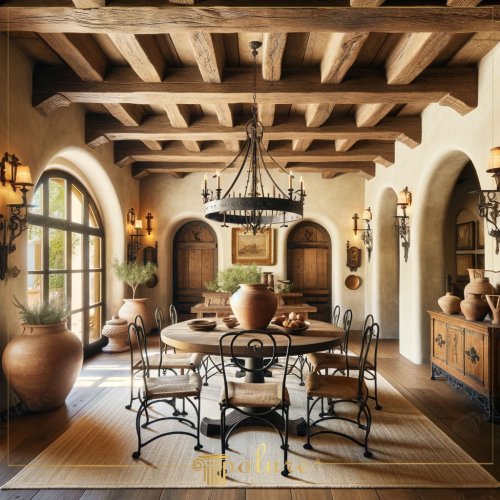
Rustic interior decoration is a design philosophy that brings warmth, naturalness and a sense of history to our homes. This unique style is enhanced with materials such as polyurethane beams, rafters, logs, cart wheels and imitation wood panels, offering a natural escape in modern living spaces.
Rustic Touches with Polyurethane Beams and Rafters
Polyurethane beams and rafters are indispensable for rustic decoration. These materials, which have the texture of real wood, offer both an aesthetic and practical solution with their lightness and easy applicability. When used on ceilings, it adds depth and character to the space.
Polyurethane Logs: Durability and Aesthetics
Polyurethane logs stand out as an excellent alternative to wooden logs. These materials, which stand out with their high durability and low maintenance requirements, allow you to bring the natural elements of rustic design to every corner of your home.
Historical Touches with Horse Carriage Wheels
Horse carriage wheels, one of the most striking elements of rustic decoration, can be used in various ways, from wall decoration to chandeliers. These historical pieces add an authentic touch to your home while also serving as conversation-starting works of art.
Wood Imitation Panels: Naturalness and Convenience
Wood imitation panels bring the warm and natural look of wood to homes, along with the advantages of polyurethane. Used on walls, floors or ceilings, these panels not only create a rustic atmosphere, but also offer practical benefits such as longevity and easy maintenance.
Classic Interior decoration - Polyurethane Classic Interior Decoration Models Designs and Ideas
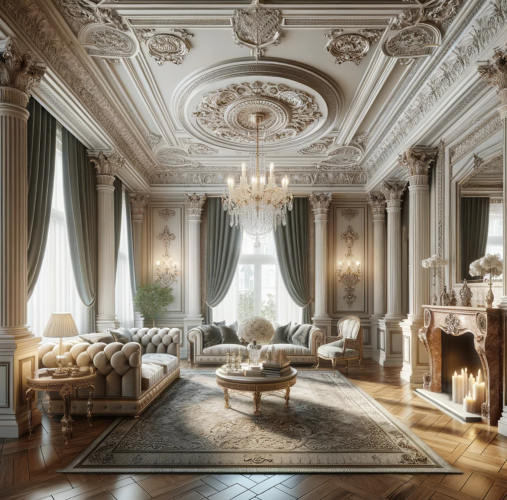
Polyurethane Classic Interior Decoration refers to using polyurethane-based materials to create traditional and elegant designs inside homes or buildings. These materials can include decorative moldings, trim, and other architectural details that add a timeless look to interiors.
Polyurethane classic interior decoration refers to the use of polyurethane materials in creating timeless and elegant interior designs. Polyurethane, a versatile plastic material, has been increasingly used in the field of interior decoration due to its durability, ease of maintenance, and aesthetic flexibility. This material can be molded into various shapes and designs, making it ideal for creating intricate decorative elements that add a touch of sophistication to any interior space. One of the key features of polyurethane in classic interior decoration is its ability to replicate the look and feel of traditional materials such as wood, stone, and metal. This makes it a cost-effective alternative for achieving a luxurious ambiance without the high expense and maintenance requirements of natural materials. Polyurethane decorative elements, including moldings, trims, cornices, and ceiling medallions, are lightweight, easy to install, and can be painted or stained to match any interior color scheme. Moreover, polyurethane is resistant to moisture, mold, and mildew, making it an excellent choice for use in various environments, including humid or coastal areas. Its insulation properties also contribute to energy efficiency, making polyurethane decorative elements not only beautiful but also functional. In conclusion, polyurethane classic interior decoration offers a blend of aesthetic appeal, functionality, and cost-effectiveness. It allows designers and homeowners to create elegant, durable, and timeless interiors that can withstand the test of time. Whether you are renovating a historic home or aiming to add a classic touch to a modern space, polyurethane decorative elements can achieve the desired effect with grace and style.Polyurethane Classic Interior Decoration
Classic interior decoration has a significant role in history, serving as a timeless style that emphasizes elegance, symmetry, and harmony. It draws inspiration from the ancient Greek and Roman designs, showcasing detailed craftsmanship and luxurious materials. This style has remained popular through centuries, influencing various aspects of architecture and design around the world.
Classic interior decoration, with its enduring aesthetic appeal and historical significance, occupies a distinguished place in the annals of design history. This style, characterized by its emphasis on symmetry, proportion, and a harmonious blend of functionality and aesthetics, traces its origins back to the ancient civilizations of Greece and Rome. Over centuries, it has evolved, influencing and being influenced by various cultural and historical epochs. The genesis of classic interior decoration can be traced back to the architectural and decorative principles of ancient Greece, which emphasized harmony, balance, and order. These principles were further refined and elaborated upon by the Romans, who introduced a sense of grandeur and luxury in the use of space and materials. The Renaissance period witnessed a revival of classical ideals, with artists and architects like Leonardo da Vinci and Michelangelo drawing inspiration from ancient models to create spaces that combined beauty, function, and human proportion. During the 17th and 18th centuries, the Baroque and Rococo styles, respectively, offered a more ornate and elaborate take on classicism, incorporating intricate decorations, bold colors, and dynamic compositions. However, the Neoclassical movement of the late 18th and early 19th centuries marked a return to the purity and simplicity of ancient Greek and Roman designs, emphasizing architectural elements such as columns, pediments, and friezes. In the modern era, classic interior decoration continues to be revered for its timeless beauty and elegance. It serves as a source of inspiration for contemporary designers who seek to blend traditional elements with modern aesthetics to create spaces that are both functional and beautiful. Whether in public buildings, luxury homes, or stylish commercial spaces, the principles of classic design remain a testament to the enduring human desire for harmony and beauty in their environments. In conclusion, the place of classic interior decoration in history is not merely as a style or trend but as a foundational element that has shaped the evolution of architectural and decorative arts. Its principles of balance, proportion, and beauty continue to influence design decisions and preferences, making it an integral part of the cultural heritage and artistic expression of societies around the world.The Place of Classic Interior Decoration in History
Polyurethane classic interior decoration features include durability, flexibility in design, resistance to wear and tear, and ease of maintenance. These materials can replicate the look of traditional wood or stone while providing cost-effective, lightweight alternatives for decorative elements such as moldings, trims, and architectural details.
Polyurethane has become a popular choice in classic interior decoration due to its versatility and durability. This synthetic material can be molded into various shapes and designs, making it an ideal choice for creating intricate moldings, ornate frames, and elegant furniture pieces that add a touch of sophistication to any room. One of the most significant advantages of polyurethane is its durability. Unlike traditional materials like wood or plaster, polyurethane is resistant to moisture, mold, and mildew, making it an excellent choice for areas prone to these issues. Its resilience also means it can withstand the wear and tear of daily life, maintaining its beauty for years to come. Polyurethane's flexibility allows for the creation of designs that would be difficult or impossible to achieve with other materials. It can be molded into intricate patterns and shapes, offering endless possibilities for customization and uniqueness in interior decoration. Despite its high-quality appearance and durability, polyurethane is a cost-effective option for interior decoration. It offers the look and feel of more expensive materials like wood or stone at a fraction of the cost, making it accessible for a wide range of budgets. Maintenance of polyurethane decorations is straightforward. They can be easily cleaned with a damp cloth, and their resistance to moisture and wear ensures they remain in excellent condition with minimal effort. As the demand for sustainable materials grows, manufacturers are producing eco-friendly polyurethane options. These variants are made from renewable resources and are designed to have a lower environmental impact, making them a responsible choice for eco-conscious consumers. In conclusion, polyurethane offers a blend of durability, flexibility, cost-effectiveness, easy maintenance, and eco-friendly options, making it an excellent choice for classic interior decoration. Its ability to mimic more expensive materials and adapt to various designs allows for creative and sophisticated interior spaces that stand the test of time.Polyurethane Classic Interior Decoration Properties
Durability
Flexibility
Cost-Effectiveness
Easy Maintenance
Eco-Friendly Options
Yes, the applications of polyurethane in classic interior decoration are distinct.
Polyurethane has become a pivotal material in the realm of classic interior decoration, offering a wide range of applications due to its versatility, durability, and aesthetic appeal. Its usage areas in classic interior decoration are diverse, catering to both functional and decorative needs. One of the primary functional uses of polyurethane in classic interiors is in architectural moldings. Polyurethane moldings are widely used for creating intricate cornices, ceiling medallions, and door and window frames. These elements add a touch of elegance and sophistication to any room, emulating the classic styles of historical periods. Unlike traditional materials such as wood or plaster, polyurethane is resistant to moisture, mold, and mildew, making it a durable choice for interior decoration. Beyond its functional uses, polyurethane also shines in decorative applications within classic interior decoration. It is utilized in manufacturing decorative elements such as wall panels, ornamental motifs, and even furniture detailing. These components can be intricately designed to mimic the look and feel of wood, stone, or metal, allowing for a luxurious aesthetic without the associated cost or maintenance requirements. The customization possibilities with polyurethane are nearly limitless, enabling designers and homeowners to achieve a personalized look that reflects their taste and the home's architectural style. Whether it's a Victorian-inspired living room or a Baroque-style bedroom, polyurethane decorative elements can be tailored to fit any classic interior theme. While polyurethane offers many benefits in classic interior decoration, it is also important to consider its environmental impact. Advances in polyurethane production have led to more eco-friendly formulations, reducing the carbon footprint associated with its use in interior decoration. Choosing recycled or green polyurethane options can further enhance the sustainability of a classic interior design project. In conclusion, the usage areas of polyurethane in classic interior decoration are indeed separated into functional and decorative categories, each serving distinct purposes. Its adaptability, durability, and aesthetic versatility make it an invaluable material in creating timeless interior spaces that pay homage to the past while embracing modern innovations.Polyurethane in Classic Interior Decoration
Functional Applications
Decorative Applications
Customization and Versatility
Environmental Considerations
Polyurethane Classic Interior Decoration Designs
Classic interior decoration never goes out of style, and polyurethane has become a popular material in achieving timeless elegance within homes and commercial spaces. Polyurethane, with its versatility and durability, offers a wide range of models for classic interior decoration that can transform any space into a luxurious haven. Polyurethane is favored for its lightweight nature, ease of installation, and resistance to moisture, mold, and mildew, making it an ideal choice for interior decorations. Its ability to mimic the look of more expensive materials such as wood, stone, and plaster contributes to its popularity in classic designs. Several polyurethane models stand out when it comes to classic interior decoration: One of the advantages of using polyurethane in classic interior decoration is the ability to customize pieces to fit specific designs and spaces. Moreover, polyurethane decorations can be painted, stained, or faux finished to match any interior color scheme, allowing for a seamless integration with existing decor. Polyurethane classic interior decoration models offer an affordable, durable, and versatile solution for creating timeless designs. Whether renovating an old space or decorating a new one, polyurethane decorations can provide the elegance and sophistication of classic decor with modern benefits.Polyurethane Classic Interior Decoration Models
Why Choose Polyurethane?
Popular Polyurethane Decoration Models
Customization and Finishing
Conclusion
Can polyurethane classic interior decoration be used outside?
When it comes to decorating our homes, both the interior and exterior spaces deserve equal attention. One of the common questions homeowners and decorators ask is whether polyurethane classic interior decorations can be used on exterior walls. This question arises due to the unique properties of polyurethane and the different environmental conditions exterior walls face compared to interior spaces. Polyurethane is a versatile polymer that can be adapted for a wide range of applications, including furniture, insulation, and decorations. It is favored for its durability, resistance to wear, and aesthetic flexibility. In interior decoration, polyurethane is often used to create ornate moldings, trims, and other architectural details that add a classic touch to modern homes. While polyurethane is durable, using it on exterior walls poses several challenges. The primary concern is its resistance to environmental factors such as UV light, temperature fluctuations, and moisture. Prolonged exposure to sunlight can cause polyurethane to discolor and degrade, losing its aesthetic appeal and structural integrity. Similarly, extreme temperatures and moisture can warp or damage the material, compromising its durability. To overcome these challenges, it is crucial to use polyurethane products specifically designed for exterior use. These products are treated with UV stabilizers and other protective coatings to enhance their resistance to environmental conditions. However, they might still require regular maintenance and reapplication of protective coatings to ensure their longevity. Alternatively, homeowners and decorators can explore other materials for exterior decorations that mimic the classic look of polyurethane. Materials such as exterior-grade PVC, fiberglass, and treated wood offer similar aesthetic appeal and are better suited to withstand the rigors of outdoor conditions. In conclusion, while polyurethane classic interior decorations can technically be used on exterior walls, it is not recommended without proper treatment and considerations. For those looking to achieve a classic aesthetic for their home's exterior, exploring materials specifically designed for outdoor use is a more viable and durable solution.Can Polyurethane Classic Interior Decoration Be Used on Exterior Walls?
Understanding Polyurethane Material
Challenges for Exterior Use
Solutions and Alternatives
Conclusion
Can polyurethane classic interior decorations be painted?
When it comes to updating the look of your home, painting can be a quick and effective way to refresh your space. One question that often arises is whether polyurethane classic interior decorations can be painted. The answer is yes, but there are some important steps to follow to ensure a successful outcome. Before painting, it's crucial to properly prepare the surface. Polyurethane surfaces should be cleaned to remove any dust, grease, or other contaminants. Lightly sanding the surface with fine-grit sandpaper can help create a texture that the paint can adhere to. After sanding, be sure to remove all dust with a tack cloth or damp rag. Not all paints are suitable for polyurethane surfaces. Water-based acrylic paints are often recommended because they adhere well and dry quickly. However, for the best results, consider using a paint specifically designed for polyurethane or plastic surfaces. These paints contain special bonding agents that improve adhesion and durability. Applying a primer is an essential step when painting polyurethane. Primer provides a uniform surface for the paint to adhere to and can significantly improve the longevity of the paint job. Use a primer designed for use on polyurethane or plastic surfaces. Allow the primer to dry completely before moving on to painting. For the best results, apply the paint in thin, even coats. Using a brush, roller, or spray can achieve a smooth finish, but each method requires a different technique. When using a brush, select one with synthetic bristles that won't leave brush marks. Rollers should be of high quality to avoid lint in the finish. Spray painting can provide a very smooth finish but requires a well-ventilated area and protective gear. With the right preparation and materials, painting polyurethane classic interior decorations is a viable way to refresh your home's look. By following the steps outlined above, you can achieve a professional-looking finish that revitalizes your space.Painting Polyurethane Classic Interior Decoration
Preparing the Surface
Choosing the Right Paint
Applying Primer
Painting Techniques
Conclusion
Applying polyurethane for classic interior decoration involves several straightforward steps. Firstly, prepare the surface by cleaning and sanding it. Next, apply a thin coat of polyurethane using a brush or sprayer, making sure to work in a well-ventilated area. Allow it to dry completely, then lightly sand the surface again. Repeat the application of thin coats, sanding between each, until you achieve the desired finish. Finally, let the final coat dry thoroughly.
Applying polyurethane is a crucial step in preserving the beauty and durability of wood surfaces, especially in classic interior decorations. This guide will walk you through the process to ensure a flawless finish. Applying polyurethane to wood surfaces not only enhances the beauty of classic interior decorations but also protects the wood from wear and tear. With the right preparation and application techniques, you can achieve a professional and durable finish that will last for years to come.How to Apply Polyurethane for Classic Interior Decoration
Materials Needed
Preparation
Application
Conclusion
Polyurethane classic interior decoration is more durable and has a higher quality finish compared to styrofoam classic interior decoration, which is lighter and less expensive but not as long-lasting or sturdy.
When it comes to classic interior decoration, both polyurethane and styrofoam materials are popular choices for creating elegant and timeless designs. However, they come with their own set of characteristics that differentiate them from one another. Understanding these differences can help homeowners and interior designers make informed decisions when selecting materials for their projects. Polyurethane is renowned for its durability and strength. It is resistant to wear and tear, making it ideal for high-traffic areas in homes or commercial spaces. Polyurethane decorations can withstand impacts and are less likely to chip, crack, or break compared to styrofoam. On the other hand, Styrofoam, while lightweight and easy to install, is less durable than polyurethane. It is prone to chipping and breaking if handled roughly, and may not fare well in areas where durability is a necessity. Polyurethane decorations are often more detailed and can be crafted to mimic the look of wood, stone, or other materials with a high degree of accuracy. The material allows for a smoother finish, which can be painted or stained to match any interior design scheme. Styrofoam decorations, while also capable of being painted, generally have a less refined finish and the details might not be as sharp or intricate as those made from polyurethane. However, for certain applications where the weight is a concern, styrofoam can be a suitable choice. The production and disposal of polyurethane can have a higher environmental impact due to its chemical composition and the processes involved in its manufacturing. It is less likely to degrade over time, contributing to landfill waste. Styrofoam, while also a product of chemical processes, is often criticized for its environmental footprint, particularly concerning waste management and its difficulty to recycle. However, advancements in recycling technologies are beginning to address these concerns. From a cost perspective, styrofoam is typically less expensive than polyurethane. This makes it an attractive option for budget-conscious projects. However, the long-term durability and aesthetic benefits of polyurethane might offset its higher initial cost for some projects. Choosing between polyurethane and styrofoam for classic interior decoration depends on several factors including budget, desired aesthetic, durability requirements, and environmental considerations. Polyurethane offers strength, durability, and a more refined finish, while styrofoam provides a lightweight, cost-effective alternative with ease of installation. Carefully weighing these aspects will guide you in selecting the best material for your interior decoration project.Difference Between Polyurethane and Styrofoam Classic Interior Decoration
Durability and Strength
Appearance and Finish
Environmental Impact
Cost Considerations
Conclusion
The difference lies in the material composition. Polyurethane is a type of plastic, while plaster is a mixture of water, sand, and cement. Polyurethane is lighter and more flexible, while plaster is heavier and more traditional for interior decoration.
Classic interior decoration often involves the use of intricate moldings and decorative elements to add elegance and character to a space. Two materials commonly used for these decorative features are polyurethane and plaster. While both can be used to achieve a classic aesthetic, they have distinct differences that make them suitable for different applications. Polyurethane is a type of plastic that is widely used in the production of moldings and decorative elements for interior decoration. It is lightweight, durable, and resistant to moisture and mold, making it an excellent choice for both residential and commercial spaces. Polyurethane elements can be easily painted, and they come in a wide range of designs, from simple to intricate. They are also easy to install, often requiring only adhesive and minimal tools. Plaster, on the other hand, is a traditional material that has been used for centuries in classic interior decoration. It is made from a mixture of water, gypsum, or lime, and it is known for its ability to be molded into highly detailed and complex designs. Plaster offers a sense of depth and texture that is hard to replicate with other materials. It is ideal for creating custom decorative elements but requires skilled artisans for installation. Plaster is also more susceptible to damage from moisture and impact compared to polyurethane. When deciding between polyurethane and plaster for classic interior decoration, consider the specific needs of your project. Polyurethane offers ease of installation, durability, and resistance to moisture, making it suitable for a wide range of environments. Plaster, while more labor-intensive and delicate, provides unparalleled depth, texture, and the opportunity for custom artistry. Your choice should be based on the desired aesthetic, the environment where the material will be used, and the availability of skilled craftsmen for installation.Difference Between Polyurethane and Plaster in Classic Interior Decoration
Introduction
Polyurethane in Classic Interior Decoration
Plaster in Classic Interior Decoration
Comparison and Conclusion
Polyurethane precast is made from a type of plastic that's strong and lightweight. GRC precast, or Glass Reinforced Concrete precast, combines concrete with glass fibers for added strength and durability.
In the construction industry, the materials used are as important as the design of the structure itself. Among the various materials used, Polyurethane Precast and Glass Reinforced Concrete (GRC) Precast stand out for their unique properties and applications. Understanding the differences between these two materials is crucial for architects, builders, and engineers to make informed decisions. Polyurethane Precast is a type of building material that is made by casting polyurethane into molds to form various architectural shapes and designs. Polyurethane is a type of polymer that is known for its flexibility, durability, and resistance to environmental factors. This material is often used for decorative elements, insulation panels, and in situations where lightweight components are preferred. GRC Precast, or Glass Reinforced Concrete Precast, is a composite material made from cement, fine aggregates, water, chemical admixtures, and glass fibers. It is known for its high strength-to-weight ratio, making it an ideal choice for a wide range of architectural and structural applications. GRC Precast is used for façade panels, architectural cladding, and ornamental shapes. Choosing between Polyurethane Precast and GRC Precast depends on the specific requirements of the project, including weight, strength, aesthetic considerations, and environmental resistance. By understanding the key differences between these two materials, construction professionals can select the most appropriate material for their projects, ensuring durability, functionality, and beauty.Difference Between Polyurethane Precast and GRC Precast
Introduction
What is Polyurethane Precast?
What is GRC Precast?
Main Differences
Conclusion
Prices for classic interior decoration with polyurethane.
In the realm of interior decoration, polyurethane has become a favored material for those seeking to infuse their spaces with classic elegance. Known for its durability, versatility, and ease of maintenance, polyurethane is often used in moldings, trims, and decorative panels, contributing to a sophisticated and timeless ambiance.
The cost of polyurethane classic interior decoration items can vary widely depending on several factors, including the complexity of the designs, the quality of the material, and the size of the items. On average, simple polyurethane decorative moldings may start from as low as $5 per linear foot, while more intricate designs can go up to $25 per linear foot or more. Ceiling medallions, another popular polyurethane decoration item, can range from $20 for basic designs to over $200 for larger and more elaborate options.
When considering the installation of polyurethane decorations, it's essential to factor in the cost of professional installation, which can vary depending on your location and the complexity of the project. DIY enthusiasts might save on these costs, but it's crucial to have the right tools and a good understanding of the installation process to ensure a polished finish.
In conclusion, while the initial investment in polyurethane classic interior decorations may seem substantial, the durability and timeless appeal of these elements make them a cost-effective choice in the long run. By carefully selecting designs that complement your space and budget, you can achieve a luxurious and enduring aesthetic.
Polyurethane Classic Interior Decoration Prices
 English
English
 Romanian
Romanian
